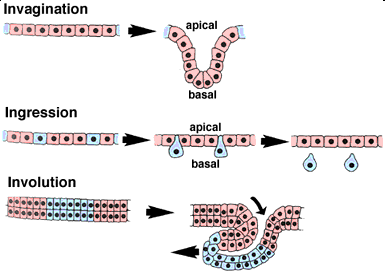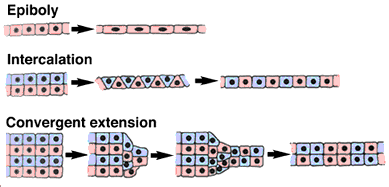Ready to test your knowledge of these movements? Click here for a quiz...


Invagination
During invagination, an epithelial sheet bends inward to form an inpocketing. One way to think of this in three dimensions is to imagine that you are poking a partially deflated beach ball inward with your finger. The resulting bulge or tube is an invagination. If the apical side of the epithelium forms the lumen (central empty space) of the tube, then the movement is termed invagination. If the lumen is formed by basal surfaces, then the movement is termed an evagination.
Ingression
During ingression, cells leave an epithellial sheet by transforming from well-behaved epithellial cells into freely migrating mesenchyme cells. To do so, they must presumably alter their cellular architecture, alter their program of motility, and alter their adhesive relationship(s) to the surrounding cells. Primary mesenchyme cells are an example of a mesenchymal cell type that emigrates out of an epithelium (do you know which one?).
Involution
During involution, a tissue sheet rolls inward to form an underlying layer via bulk movement of tissue. One helpful image here is of a tank tread or conveyor belt. As material moves in from the edges of the sheet, material originally at the sites of inward rolling (shown in blue here) is free to move further up underneath the exterior tissue.
Epiboly
During epiboly, a sheet of cells spreads by thinning. i.e., the sheet thins, while its overall surface area increases in the other two directions. Epiboly can involve a monolayer (i.e. a sheet of cells one cell layer thick), in which case the individual cells must undergo a change in shape. In other cases, however, a sheet that has several cell layer can thin by changes in position of its cells. In this case, epiboly occurs via intercalation, one of the other movements described on this page.
Intercalation
During intercalation, two or more rows of cells move between one another, creating an array of cells that is longer (in one or more dimensions) but thinner. The overall change in shape of the tissue results from cell rearrangement. Intercalation can be a powerful means of expanding a tissue sheet. A specialized form of intercalation is convergent extension, which is described on this page.
Convergent Extension
During convergent extension, two or more rows of cells intercalate, but the intercalation is highly directional. Cells converge by intercalating perpendicular to the axis of extension, resulting in the overall extension of the tissue in a preferred direction. If we had a way to label cells from rows on either side of the axis of extension, they would be found to mix with one another as a result of these oriented intercalation events.